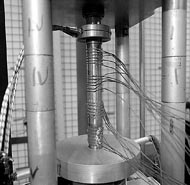 Thermal conductivity measurements are performed in the thermal contact
resistance rig, a test apparatus enclosed in a Pyrex bell jar connected to
a vacuum system which combines a mechanical pump connected in series with
an oil diffusion pump. Using this system, a vacuum lower than 1E-07 torr
is attained under ideal conditions, which stops any heat transfer from the
test apparatus due to convection. The test column used for thermal
conductivity measurements consists of two ARMCO iron heat meters placed
in contact with the upper and lower surface of the test specimen.
Thermal conductivity measurements are performed in the thermal contact
resistance rig, a test apparatus enclosed in a Pyrex bell jar connected to
a vacuum system which combines a mechanical pump connected in series with
an oil diffusion pump. Using this system, a vacuum lower than 1E-07 torr
is attained under ideal conditions, which stops any heat transfer from the
test apparatus due to convection. The test column used for thermal
conductivity measurements consists of two ARMCO iron heat meters placed
in contact with the upper and lower surface of the test specimen.
This column is located between a heater block, consisting of pencil-type
resistive heaters embedded in a brass block, and a closed-loop constant
temperature bath cooled cold plate. A load is applied to the test column
using a diaphragm-type air cylinder and the contact pressure is measured
by a calibrated load cell. The mechanical loads, heater power and
temperature readings of the heat meters are measured and controlled using a
data acquisition system connected to an IBM PC compatible computer. By
varying the power dissipated by the heater block, the thermal conductivity
of the test sample can be determined as a function of its mean
temperature. This measurement technique has been used successfully for a
wide variety of materials, including various aluminum alloys and other
metals and silicon-based rubbers.
|





 Thermal conductivity measurements are performed in the thermal contact
resistance rig, a test apparatus enclosed in a Pyrex bell jar connected to
a vacuum system which combines a mechanical pump connected in series with
an oil diffusion pump. Using this system, a vacuum lower than 1E-07 torr
is attained under ideal conditions, which stops any heat transfer from the
test apparatus due to convection. The test column used for thermal
conductivity measurements consists of two ARMCO iron heat meters placed
in contact with the upper and lower surface of the test specimen.
Thermal conductivity measurements are performed in the thermal contact
resistance rig, a test apparatus enclosed in a Pyrex bell jar connected to
a vacuum system which combines a mechanical pump connected in series with
an oil diffusion pump. Using this system, a vacuum lower than 1E-07 torr
is attained under ideal conditions, which stops any heat transfer from the
test apparatus due to convection. The test column used for thermal
conductivity measurements consists of two ARMCO iron heat meters placed
in contact with the upper and lower surface of the test specimen.